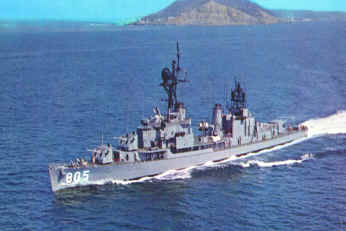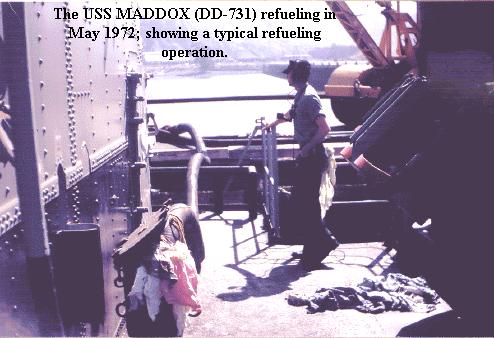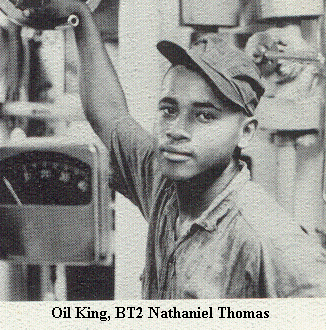|

OIL SPILL IN THE WARDROOM
By Richard H. King, CDR USNR-Ret.
At the time of this story, CDR King was LT JG, Main Propulsion
Assistant (1965-1968),
(Assistant Engineering Officer for Main Propulsion)
U.S.S. CHEVALIER (DD-805)
I think this story happened in
1967, but I am not quite sure. And
I am not absolutely sure who the Oil King was, although I thought it was BT2 Nathaniel Thomas, but when I sent
him a draft of the story he did not respond.
It all started with a gunnery exercise at San Clemente Island, the
Navy’s gunnery practice island not too far from San Diego.
We shot, and we shot, and we shot. Chevalier
did have six good five-inch guns and they worked and they were accurate.
Oil King was, although I thought it was BT2 Nathaniel Thomas, but when I sent
him a draft of the story he did not respond.
It all started with a gunnery exercise at San Clemente Island, the
Navy’s gunnery practice island not too far from San Diego.
We shot, and we shot, and we shot. Chevalier
did have six good five-inch guns and they worked and they were accurate.
After the shoot was over, we
pulled into San Diego Harbor and because this was an ongoing exercise, we tied
to one of the buoys near Shelter Island and Shelter Island Yacht Club rather
than go all the way up to 32nd Street. I was a brand new CDO (Command Duty Officer, the officer in
charge of the ship in port). Captain
Kirk was unusual. At first the
Chief Engineer, the Operations Officer and the Supply Officer all had CDO Watch
Stander’s Liberty. The Weapons
Officer complained, so he got it also. So
all of our CDO’s were junior officers, essentially all of the O-2’s on
board. But whoever
assigned the duty roster wasn’t thinking.
There were not enough Ensigns to cover all five duty sections, so a few
of the CDO’s would go solo. Instead
of giving an Ensign to the least experienced CDO, the senior CDO’s got them.
In Duty Section II, I was solo, the only officer on board the ship.
Ensigns don’t know much, but they can be helpful.
 We were supposed to go back
out to the “Exercise” in the morning and I was told to refuel the ship that
night. The Port Services people
brought a fuel barge along side just after dark.
At this point and
time, I was wearing several “hats”. I
was CDO, MPA, and Fueling Officer and the only officer aboard. If anything went
wrong with the refueling, it was going to be hard to blame someone else. We were supposed to go back
out to the “Exercise” in the morning and I was told to refuel the ship that
night. The Port Services people
brought a fuel barge along side just after dark.
At this point and
time, I was wearing several “hats”. I
was CDO, MPA, and Fueling Officer and the only officer aboard. If anything went
wrong with the refueling, it was going to be hard to blame someone else.
We started fueling the forward
tanks first and everything seemed to be going perfectly.
Obviously, the one place I “wasn’t” that night
was in the wardroom. And
since I was the only officer on board, the wardroom was deserted.
Then someone went by the door to the Wardroom and reported that black
oil, NSFO, was pouring out from under the Wardroom door,
crossing the deck, spilling over the side and heading for Shelter Island Yacht
Club. When the problem was called
to my attention, I ran to the door to the wardroom and opened the door.
Black oil gushed out and over the side.
The oil was heading to Shelter Island Yacht Club.
“Oh Shit!” (Almost
all my stories have that phrase in there somewhere).
I shut down the
refueling barge and I am not sure what I did next.
But after a few minutes I had my Boatswain’s Mates in the boat with a
fire hose to try to contain the spill and I had sent reports of our
“troubles” to all the proper authorities, both civilian and military.
 The Navy had an
“oil spill recovery vessel” on the scene very quickly and between our motor
whaleboat with a fire hose and the “recovery vessel”, that problem was
quickly solved. We went ahead and
filled the after tanks from the barge while the clean up effort was still going
on around us. After
the barge was gone, I went to the wardroom.
I was amazed. Every engineer on board, whether “M”, “B” or “R”,
whether in the duty section or just returned from liberty, was on his hands and
knees cleaning the wardroom carpet with JP5.
I didn’t order that! To
this day I don’t know who organized it, perhaps the oil king.
It was a disaster about to happen, but I let them continue after putting
the smoking lamp out throughout the ship. A
spark or match in the wardroom that night would have created a fiery inferno.
But amazingly, the carpet cleaned up nicely (it was dark blue and black
to begin with). The drapes on
the other hand were a total loss. The Navy had an
“oil spill recovery vessel” on the scene very quickly and between our motor
whaleboat with a fire hose and the “recovery vessel”, that problem was
quickly solved. We went ahead and
filled the after tanks from the barge while the clean up effort was still going
on around us. After
the barge was gone, I went to the wardroom.
I was amazed. Every engineer on board, whether “M”, “B” or “R”,
whether in the duty section or just returned from liberty, was on his hands and
knees cleaning the wardroom carpet with JP5.
I didn’t order that! To
this day I don’t know who organized it, perhaps the oil king.
It was a disaster about to happen, but I let them continue after putting
the smoking lamp out throughout the ship. A
spark or match in the wardroom that night would have created a fiery inferno.
But amazingly, the carpet cleaned up nicely (it was dark blue and black
to begin with). The drapes on
the other hand were a total loss.
A careful investigation
the next day showed that the aluminum fuel trunk, on the O-1 level, had cracked
during the gun shoot and that’s why the oil leaked into the
wardroom. I wish I was sure who was
Oil King that night. I still think
it was BT2 Nathaniel Thomas from the Eastern shore of Virginia. An outstanding sailor, 4.0, and one of very few blacks we had
in either M or B Division.

Now for some definitions:
-
BTC stands for "Boiler
Technician Chief"
(E-7) in olden days "Boiler Tender Chief".
-
MM stands for "Machinist Mate", the rate
that handled the steam turbines, turbo generators, evaporators, condensers,
etc.
-
In simplistic terms, the "BT's" made the steam and the
"MM's" put that steam to work and sent the condensate back to the
BT's to make more steam. It was called the
"steam cycle" because in theory you used the same water over and
over and over again.
-
"MPA" stood for "Main Propulsion
Assistant" which I describe to civilians (easier to understand) as
"Assistant Engineering Officer for Main Propulsion". Or on a
merchant steamship, "First Engineer" (after the Chief
Engineer).

 

|
